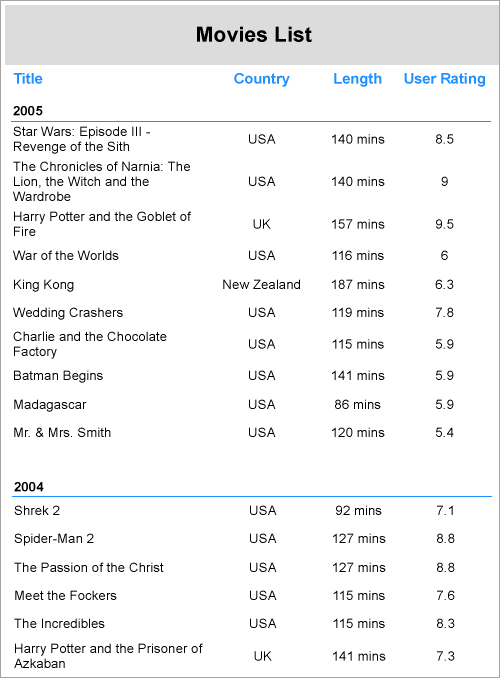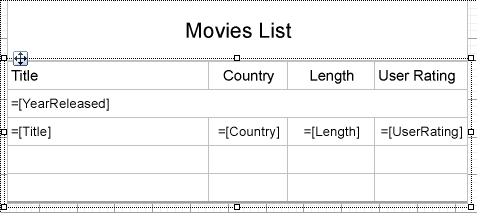Create Tabular Report with Table Data Region
In This Topic
Let us create an RDLX report that uses the Table data region to display the movie details including its name, released year, country, duration, and user ratings. The report connects to the 'reels.db' data source available on GitHub.
The final report will look as shown. The data in the table is grouped by the released year of movies.

Create a Report
In the ActiveReports Designer, create a new RDLX report.
If you are creating a new report in the Visual Studio Integrated Designer, see
Quick Start.
Bind Report to Data
As you create a new report, you can configure the report data connection in the Report Wizard. You can also access the Report Data Source dialog by right-clicking the Data Sources node in the Report Explorer and then selecting the Add Data Source option. See SQLite for details.
- On the Choose Data Source Type screen of the wizard, select SQLite and click Next.
- To specify the DataBase Path, click the Browse button and navigate to the desired file on your system. For example, you can connect to the Reels.db sample data source which can be downloaded from GitHub.
- Click Test Connection to test the connection.
- Then click the Next option and configure the dataset by adding a valid query.
| Dataset Query |
Copy Code
|
| SELECT * FROM Movie |
- Into the Name field, enter the name of the dataset as MoviesDataset.
- Click Next to proceed to the final screen of the Report Wizard.
- On the final screen of the Report Wizard, review the summary of the report and click Finish to successfully add the report with the SQLite data source.
Design Report Layout
- Drag and drop the Table data region on the report’s designer.
- From the dataset, drag the following data fields to the Details row of the Table data region: [Title], [Country], [Length], and [User Rating]. The Header row above the Details row is automatically filled with labels.
- To display the movie length in minutes, select the [Length] textbox and set its Format property to ### mins.
- With the Table data region selected, click the Property dialog link to open the Table dialog.
- Go to the Groups page and click Add.
Note: Alternatively, you can add a group by selecting Insert Group in the context menu of the Table data region, and adding a group in the Table - Groups dialog that opens.
- Set the Group on Expression to =Fields!YearReleased.Value.
This will ensure that the data in the table is grouped based on the [YearReleased] field.
- Navigate to the Sorting page. Set the Sorting Expression to =Fields!YearReleased.Value and Sorting Direction to Descending.
- In the Layout tab and check the Keep together on one page if possible option.
This property will try to fit the entire group on the same page; either on the current page or on the following page. If this is not possible due to a large number of records, the content will split across multiple pages.
- Click the OK button to close the dialog. A Group Header and a Group Footer are added.
- Merge the cells in the Group Header row and enter the expression in the Value property as =[YearReleased].
This makes the group value appear and span above each group.
- To add the report title, drag and drop the TextBox control to the PageHeader section and set its Value property to 'Movies List'.

- Improve the appearance of the report and preview.
See Also

